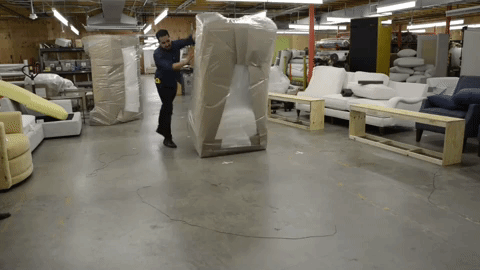
EXPLORE JONATHAN LOUIS PRODUCTS
By Collection
By Product
Falling with Style: Drop Testing JL Product

Picture it: you’ve been waiting days, weeks, or even months for something you bought to be delivered…and it shows up dented, banged up, damaged, or in the worst cases, destroyed. Can you feel the disappointment?
The reality of shipping things–especially heavy things like furniture–is that accidents will happen, and someone will drop your precious couch at least once while moving it. While we can’t prevent damage from happening 100% of the time, we can certainly try to do everything in our power to ensure our furniture survives the trip to your home (or to retail stores), whether it’s down the street, or 2500+ miles to the Atlantic coast.
How? Well, by testing our packaging by dropping our packaged furniture. A lot.
Many of our retail partners have specific protocols to ensure the packaging meets the transportation environment. We go above and beyond what our partners request from us, like dropping it from higher heights and many, many, more times than requested.
For example, in this video, we even “vertical freefall” drop tested the piece–which is dropping it from a completely upright position–a more rigorous testing standard than was required. Why is it considered more rigorous? It’s unlikely that the furniture would fall that way because usually someone is always handling it, but we tested it regardless of likelihood.
Yes, there are specialist agencies that actively try to destroy furniture in transit for a living to test packaging (great for people working through some issues) that can do this for us. But, sometimes, for expediency’s sake, we recreate the scenarios with our engineering and QC teams.
And while our retail partners didn’t ask that we film the process, we believe in transparency, and quite frankly, entertainment, so now you too get to enjoy footage of us repeatedly yanking on, dropping, and pushing pieces of furniture.
One surprise benefit of testing in-house rather than outsourcing it? Ingenuity from our teams.
This rigorous testing helped create a new way of packaging that uses less cardboard and packing material, while still providing the same amount of coverage and protection, making it a more streamlined and environmentally-friendly option than traditional boxing…but that’s for another post.
.png)